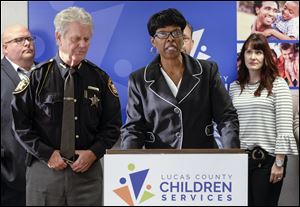
More Lucas County children enter foster care as opioid crisis continues
12/21/2017
Robin Reese, of Lucas County Children Services, speaks as she and Sheriff John Tharp, left, announce a new partnership between DART and children services to better serve families with addiction problems during a press conference in October.
More Lucas County children are in foster care now than at this time last year, and child-welfare officials worry the number of children in need soon will outpace the capacity of foster homes available to take them in.
Lucas County Children Services this month tallied 1,021 children in agency custody or in the custody of a relative, with the overwhelming majority in foster care, agency spokesman Julie Malkin said. That’s an increase of 95 children from December, 2016, with only 260 foster homes licensed through the agency.
Robin Reese, Lucas County Children Services’ executive director, attributes much of the increase to the opioid epidemic. As of September, 56 percent of children in the agency’s custody were there because of opioids, Mrs. Reese said.
“This is not unique — this is around the state,” she said. “On any given day we can have another county calling us, asking us for a foster home or a placement resource for their children.”
A report released Thursday by Columbus-based Public Children Services Association of Ohio shows the number of Ohio children in foster care has jumped by more than 1,700 in the past 15 months.
In July, 2013, there were 12,654 children in foster care on any given day in Ohio, according to the report. Three years later, that number had climbed to 13,769, and by July, 2017, it spiked to 15,145, with only 7,200 foster homes available statewide.
On Oct. 1, the number of Ohio children in foster care surpassed 15,500, and child-welfare officials don’t see those numbers retreating.
“I’m not surprised,” Mrs. Reese said. “In speaking to directors all around the state of Ohio, our system is absolutely drowning.”
In 2015, half of all children taken into custody across Ohio had drug-user parents, and 28 percent had parents who were opioid users, the report said. For Lucas County, those figures were 59 percent and 37 percent, respectively, and they’ve gone up since then.
Mrs. Reese said the opioid epidemic has affected the child-welfare system in several ways. More children are coming into agency care, but they’re also staying in foster homes longer. Reuniting children with birth families has become increasingly difficult as parents relapse or die of overdoses, she said.
There’s also a heightened financial strain as more resources are needed to care for children who enter foster care with trauma.
This year Lucas County Children Services spent more than $1 million each month on costs associated with finding children the proper placement, more than double the $400,000 monthly outlay five years ago and $100,000 more than last year.
The Public Children Services Association report predicted there will be more than 20,000 Ohio children in need of foster care by 2020, and the cost to agencies likely will skyrocket alongside the need. It’s a figure Scott Britton, the association’s assistant director, said may “simply be unsupportable” without rethinking the system.
“We want to sound this alarm today because we still have time to begin thinking through the changes that need to be made in order to accommodate the growth we’re projecting here,” he said.
In Lucas County, the main focus is on recruiting more foster families to provide loving, stable homes to children in need.
“The fact that they are in this situation is no fault of their own,” Mrs. Reese said. “We really need people in this community to step up and help us.”
Lucas County Children Services’ next training session for foster and adoptive parents begins Jan. 9 and runs through mid-February. Call 419-213-3336 for more information.
Contact Sarah Elms at selms@theblade.com, 419-724-6103, or on Twitter @BySarahElms.